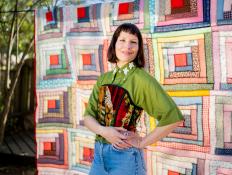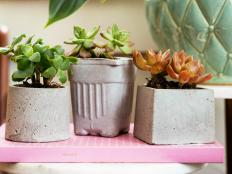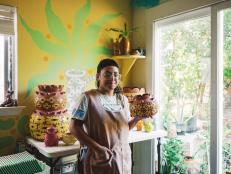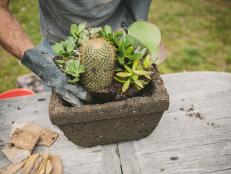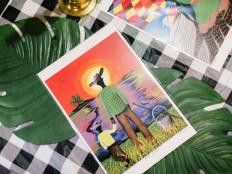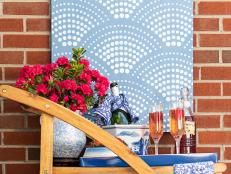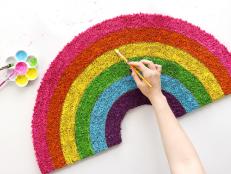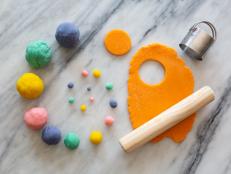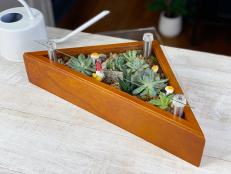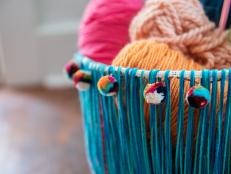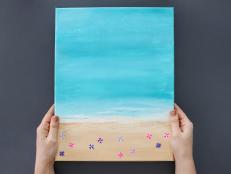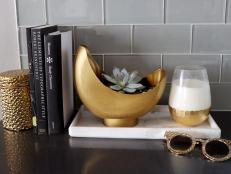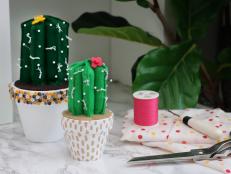How Ceramic Artist Gabo Martinez Preserves and Celebrates Mexican Culture Through Her Vibrant Pottery
Mud slinger Gabriela "Gabo" Martinez is proud of her roots and intentional about celebrating and preserving Mexican culture through her work. Take a look inside her home studio and learn how she connects with her heritage to create her distinctive signature ceramic pots in this Q&A.

Arnelle Lozada

Whether it’s her effortless style, her strong sense of identity and unwavering pride in her Guanajuatense and Xicanx heritage, or the fact that she’s a magic-making, wise-word-spitting, mud-slinging artist — there are many things to love about Gabo Martinez. Born in Guanajuato, Mexico, in 1995, her family relocated to Texas in 1997 and she received her degree in studio art with a concentration in ceramics from Texas State University in 2018. She currently lives and works in San Marcos, Texas, and has been playing with clay for more than five years now.
Her work has graced the shelves and walls of numerous Texan galleries and even Austin’s mega-stylish Austin Proper Hotel. While undoubtedly stunning, her work carries much more significance than just a beautiful piece for your home. Gabo is a force — a vessel through which cultural traditions and messages are passed down, and her work is the physical manifestation of those messages channeled through her spirit and intuition. Each piece is a love letter to her roots, and through her work she hopes to celebrate Mexican culture as well as inspire a desire among her fellow artisans to connect to their own heritage and what makes them who they are.

Arnelle Lozada
How did your love story with pottery begin? What sparked your relationship with clay and the Earth?
My love story with clay began in my teenage years during high school. Growing up, creativity served as my escape from life’s challenges. In creative spaces I discovered a sense of freedom and playful curiosity. It was only natural for me to gravitate towards pottery. During high school, I crafted several hand-built forms and also learned the [ceramic decoration] technique of Sgraffito, which I continue to employ in my craft to this day.
Your work is incredibly intricate and detailed. Can you share a bit about your process? How long does it take for you to create a batch of work?
My process is akin to the relief-carving technique used in linoleum printing. However, it starts with painting the piece, followed by carving the design into the leather-hard slip. This carving method, or "sgraffito," feels like drawing onto clay.
Most of my forms begin as wheel-thrown pieces, then I later alter off the wheel. Once the form reaches the leather-hard stage, I begin the painting and carving process. To ensure precision, I use watered down food coloring gel to create initial linear guides on my pieces before I start drawing and carving. Each piece goes through two separate firings as part of the process. Ceramics is a time-intensive art, and I find joy in experiencing the process slowly. It typically takes about two months to complete a batch or series of pots.

Arnelle Lozada
"Leather-hard" clay refers to partially dried clay. When crafting pottery, this stage of the process is important for making refinements and artistic adjustments to pieces because the clay is strong, yet still wet enough to be shaped, carved and/or worked. "Sgraffito" is a technique where glaze or slip is applied to the pottery, and once it’s dry, a tool is used to carve or etch designs into it.
How does your culture influence your art?
My art is deeply influenced by my cultural background. I choose to be intentional about the narratives and visual languages that shape my work. I’ve always seen my work as an expression of my identity. Growing up in Mexico, I have vivid memories of being surrounded by earthenware structures constructed from terracotta bricks adorned with colorful stucco. These vibrant experiences from my early years are reflected in the vividness of my work, and that’s one of the reasons I choose to primarily work with red clay or "barro rojo."

Arnelle Lozada
There's a lot of deep history and important messages embedded into your pieces. Can you share some of that historical significance and some of the messages conveyed?
The motifs in my work draw deeply from the visual legacies of Mexicanismo, a cultural movement that celebrates Mexican identity and heritage. I challenge myself to never directly appropriate a form or surface design; instead, I allow the energy and essence of my culture to inspire my creations.

Arnelle Lozada
In my pieces, you’ll find elements that pay homage to the rich history of Mexico, such as the vibrant colors and contrast of Mexican folk art and the intricate patterns of Talavera pottery from Guanajuato. These historical references are embedded in my work to convey a sense of pride and connection to my cultural roots.
Why is it important that you convey those messages and share that history?
I believe that as an artist, I have a unique privilege and responsibility to be intentional about the impact I make in creative spaces. Working with clay is not just a craft but a medium through which I can authentically express myself.

Arnelle Lozada
My art conveys messages of resilience, unity and the importance of preserving traditions, and is a reflection of who I am and where I come from. It serves as a bridge between my heritage and the wider world, reminding us of the enduring beauty of Mexican heritage. By incorporating the symbols and narratives of my culture, I aim to preserve and celebrate the rich history of Mexico.
Sharing these messages and history is a way for me to contribute to a more diverse and inclusive art landscape. It’s about creating awareness and appreciation for the diversity of artistic voices and cultural perspectives. Ultimately, my goal is to inspire others to explore their own cultural identities and the stories that make them unique.
Would you say that tapping into your cultural heritage and connecting with your roots has opened your art up in new ways?
Exploring my cultural heritage and connecting with my roots has undeniably opened up new dimensions in my art. It’s a profound connection that truly comes to life when I’m in the creative flow, working intuitively. Over the years, as my art has evolved, I’ve discovered more and more parallels between my heritage and my work. This journey has encouraged me to embrace designs that pique my curiosity, to stay open and inquisitive. I’ve come to understand that creativity thrives in a space that feels safe, even when it might seem silly or unproductive. I invest in rituals and environments that nurture my creativity and keep me connected to the source of inspiration, which often lies in my cultural roots.

Arnelle Lozada
Why is it important for people to support makers and be willing to invest a little more in handmade items?
I firmly believe in the significance of consumers supporting makers and being willing to invest a little more in handmade items. It’s a call for mindfulness in how we spend and allocate resources. When we make intentional choices as consumers, we participate in a subtle yet transformative shift in the economy, one that invests in our local and global communities.
Handmade items are not just products; they are infused with the energy and intention of the artisans who craft them. These artisans channel their creativity and passion through their hands onto the material, resulting in a unique and personal connection between the creator and their creation. This special energy is what sets handmade art apart from mass-produced items.

Arnelle Lozada
Investing in handmade art is an investment in the preservation of craftsmanship, cultural traditions and individual creativity. It’s a way to acknowledge and celebrate the artists behind the art, connecting with the human stories woven into each piece. So, I encourage people to consider the value of this unique energy and intention when deciding how to invest in art.
What have been some of the challenges and barriers to entry you've faced as a ceramic artist?
I’ve faced numerous challenges throughout my career as an artist, and it’s important to acknowledge these hurdles. It’s been a somewhat bleak journey, but I want to be candid about the obstacles I’ve encountered, particularly as a Latinx creative hailing from a working-class background.
Within my community, art isn’t always viewed as a valued career path, and my family initially hoped I would become an educator. I entered college with the intention of studying art to teach kids after graduation. This lack of family guidance or connections to artistic careers made it a solitary journey from the start. Over time, I’ve struggled with the absence of role models or mentors who share my cultural background. I’ve leaned heavily into the guidance of those I considered mentors, seeking support and direction. While I am grateful for the support I received, I’ve also faced criticism that didn’t take into account the complexities of my cultural and socio-economic background.

Arnelle Lozada
The ceramic community in Texas, like many craft communities, is predominantly white, and it can be challenging to find spaces that don’t make you feel like an outsider. While clay people are generally nice, their actions can sometimes be inadvertently harmful, especially when there’s a lack of accountability and inclusivity. During my undergrad years, I made earnest efforts to access local creative spaces but was always met with the response that there was no room for me. It was disheartening to witness these same spaces later open up to accommodate my white peers after I had graduated. This experience highlighted the disparity in access and opportunities that many BIPOC craftspeople face.
Can you share any guidance on how to overcome some of those hurdles for other BIPOC craftspeople?
One thing I’ve found is that if you take a pottery class, many places are becoming more accessible and inclusive, so don’t hesitate to inquire about sliding-scale tuition or scholarships. Creative spaces should be open to everyone, and you deserve the opportunity to explore your artistic passions.
The reality is that most creatives who are fortunate enough to choose art as a career come from a place of incredible privilege. Artists with a working-class background, like myself, are a minority in this field. These everyday realities can be immensely difficult to navigate, and there have been many moments when I’ve contemplated quitting art altogether.

Arnelle Lozada
But resilience is critical when pursuing this path. I find solace in celebrating the small victories and marveling at what I’ve managed to achieve despite the formidable obstacles. The struggle has equipped me with an unwavering drive to persevere and an exceptional work ethic. I’m grateful to have cultivated a community and a home studio space, even if it’s messy, small and shared. It marks the beginning of a new chapter in my artistic journey.
What tips or insights can you share for folks who have been curious about pottery but don't know where to start?
For those curious about starting their journey in pottery, my advice is to begin by understanding what kind of environment nurtures your creativity. Sometimes, social environments can be a bit challenging because of the tendency to compare yourself to others. If this has been an issue for you in the past, consider setting up a basic home studio. You don’t need a lot of equipment to get started; a banding wheel, clay and a few tools would suffice. We’re fortunate to live in an age where technology has made various techniques and teachings readily accessible, enabling you to be a self-taught potter. However, remember that the mud demands patience, discipline and practice. If you’re comfortable in a social setting, I’d recommend taking classes at studios that align with the type of pottery you’re interested in.

Arnelle Lozada
What are the pottery tools you can’t live without?
The pottery tools I can’t live without include carving and sgraffito tools, such as small loop tools, a ballpoint stylus wrapped in soft tape and a large bamboo brush for surface cleaning. I also rely on a dividing disk for planning and breaking up space and form in my designs.
Ceramic Art Tools
What are the must-have tools you'd suggest for all aspiring ceramic artists?
The choice of tools in ceramics can be highly subjective. It’s crucial to consider your budget and which techniques align with your artistic curiosity within your clay practice. A banding wheel is a great initial investment, especially if you plan to pinch or coil build at home.
As you progress in your ceramic journey, the creative process will naturally guide you towards the tools that will enhance the efficiency of your techniques. It’s also essential to be mindful of your body, paying attention to posture and hand movements. If a particular technique is causing discomfort or pain, it’s important to discontinue it and explore alternatives that feel more comfortable and sustainable for your body.

Arnelle Lozada
What's one thing you wish you knew in your early days as an artist? Something you can impart to others so they can get ahead of it or avoid making the same mistake?
If I could go back to my early days as an artist, one thing I wish I had known is not to be so susceptible to the feedback of others, particularly when that feedback is rooted in their own insecurities. My work has always carried a unique power and is a reflection of my intuitive connection with the spirit.

Arnelle Lozada
Instead of making myself small to accommodate the comfort of others, I wish I had embraced my power and ability to disrupt the energy in predominantly white spaces. Over time, I’ve learned to take up space and advocate for myself as a creative. I initially thought I needed a chair at the table, now I’ve realized that I can make my own table and invite others who are also aligned within. I now recognize the worth of my work and have been more intentional about surrounding myself with a community that nourishes my spirit and values me, rather than seeing me as intimidating or threatening.
Learn more about Gabo Martinez and upcoming shows at GaboMartiniPotts.com, and follow along with her mud-slinging adventures at @gabomartinipotts.
Gabo's responses have been edited for grammar and clarity.











